Insulators have been around longer than
most people realize. The first rudimentary telegraph line was
built between Paris and Lille, France in 1793. The need for insulators
to insulate the wire from grounding out soon became apparent.
There were a number of early experimental lines in Europe and
the United States before Samuel F. B. Morse finally developed
a fully functional and commercial system using his particular
code. He built his first commercial line between Baltimore and
Washington, D.C. in 1844.
Insulators were first used extensively in
the mid-1840s with the invention of the telegraph. They were necessary
to prevent the electrical current passing through the wire from
grounding out on the pole and making the line unusable. The first
insulators were a beeswax soaked rag wrapped around the wire.
They worked well in the dry laboratory but soon broke down when
exposed to the weather. The next concept was a glass knob, which
looked much like a bureau knob one might still find on antique
furniture today, mounted on a wood or metal pin. From this evolved
the pin style insulator, which had no threading inside the pinhole.
It was cemented to the pin by driving it down on the pin with
a mallet on an asphalted rag. This was not a perfect answer because
the weather worked on the rag and eventually the insulator would
work loose and pop off the pin allowing the wire to contact a
grounding surface. Inevitably, however, as telegraph lines traced
the westward expansion of railroad lines across the states, glass
manufacturers began to create many new designs in an effort to
secure a niche in the rapidly growing insulator market.
Thus, by the advent of the Civil War in
1860, original insulator models could be found in both porcelain
and glass. While glass was more common from the beginning for
telegraph and telephone line insulation, porcelain would later
gain a firm foothold as the preferred material for insulating
high voltage power lines. Over time, glass manufacturers would
produce hundreds of designs; millions of insulators were made
of glass and porcelain, then later of rubber, plastic and other
composite materials.
While even the earliest mass-produced insulators
were constructed with the still familiar wire grooves through
which the line wires run, insulators were at first made with non-threaded
pinholes. The insulator was simply stuck on the top of a wooden
peg or branch. It wasn’t until July 25, 1865 that a carpenter,
Louis A. Cauvet, invented and patented the threaded pinhole design
we still find in insulators lying along old railroad tracks throughout
the country. It was a method for threading the inside pinhole
of the insulator, which then could be screwed down on a threaded
wood or metal pin.
Though Cauvet’s concept was at first
ridiculed as too inefficient as it made installing insulators
more time consuming, his design succeeded in ensuring the insulators
wouldn’t fall from their lofty perches when battered by heavy
winds and storms—a significant problem with non-threaded
designs. Ultimately the Brookfield Company purchased Cauvet’s
patent and the design turned out to be so successful it remains
basically unchanged even on modern porcelain insulators.
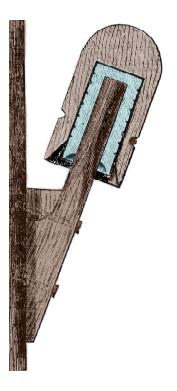
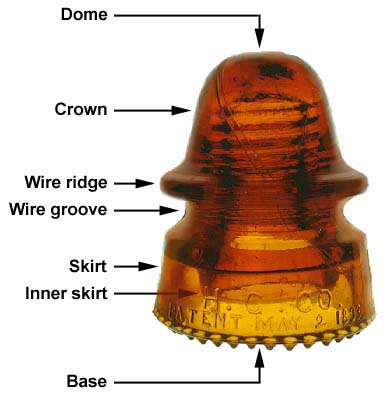 Cross-sectional Drawing
Parts of a typical insulator
This is an example of how insulators are attached
Cross-sectional Drawing
Parts of a typical insulator
This is an example of how insulators are attached
The cross section shows the wood covering
enshrouding a Wade glass insulator, which is attached to the wooden
pin on the bracket.
This cut was taken from the book "Modern
Practice of the Electric Telegraph" by Frank L. Pope
(1869) which depicted the insulator styles commonly used in that
period and especially during the Civil War.
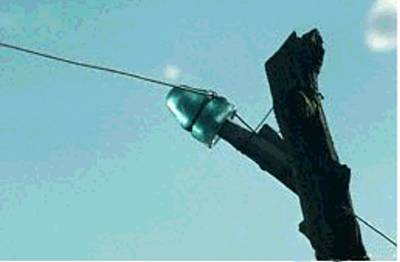 Insulator on telegraph pole
Insulator on telegraph pole
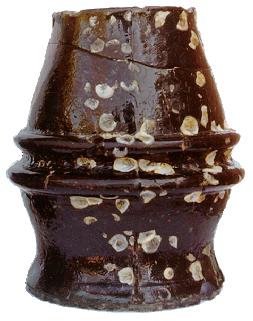
The "Confederate Egg" telegraph
line insulator was so called because it resembled an egg. The
wire groove is very noticeable in the center. The South had the
capacity to reproduce enough insulators to cover normal wear and
tear. It didn’t have the ability to mass-produce the number
needed after the war started due to deliberate damage inflicted
by opposing troops. So the ones you see on display represent very
crude manufacture of insulators for telegraph lines for the Confederacy.
The above example was found in Mobile Bay,
Alabama. They were very rare until a large cache was found in
remains of a Confederate Storage Depot in Richmond, Va. in 1990.
Richmond was the capitol of the Confederate States. Rebels torched
the depot during Yankee advances in April 1865. There are many
colors including deep greens, emerald greens, and cobalt. All
glass "eggs" of these types possibly were made at Richmond
Glass Works, known to have made telegraph insulators of some sort
during the war.
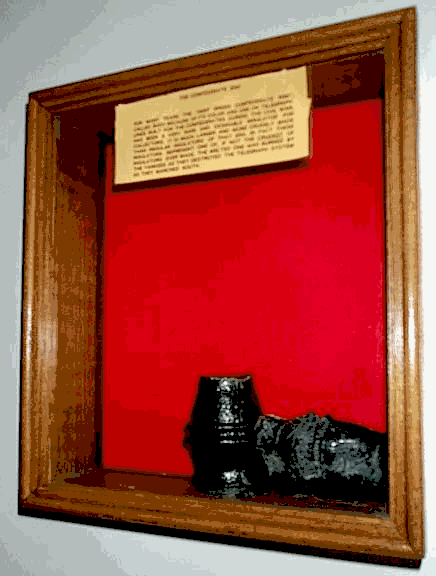
We at the Drum are proud to have on display
the above Confederate "Eggs." Sherman’s Yankees
burned the melted one as they destroyed the telegraph system when
they marched to the sea.
(We have no information of when
or where they were found)
There is a whole subculture dedicated to collecting insulators,
especially in the U.S. and also the world. Much more information
can be found on the web and at public libraries.
Bibliography:
"Early & Unused Telegraph Insulator," by Mike Guthrie
"History of Insulators," by Mike Scott of "Glass House Productions"
"Insulators thru the Ages,"
by Jim Woods: and photos from the
web site of Bill Meier called,"Glass Insulators."
Floyd Farrar, Drum Volunteer,
June 2001.